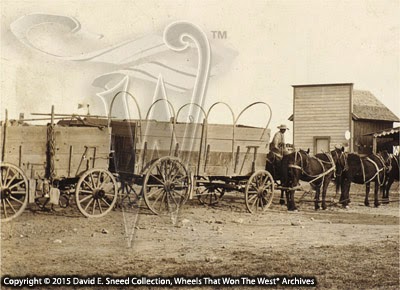The
older I get the more complex the world seems to be. Yes, I know, some parts of life do appear to
be simpler but consider this… when many of us were kids, something as
straightforward as a watch was, well, just a watch. The band was either elastic, had a clip, or
small buckle. That was the end of the
frills. There were no digital read-outs,
just an hour, minute, and “sweep” second hand.
Today, the watch many of us use is also a phone and flashlight as well as
a still camera and video recorder that shows multi-year calendars, sends emails
and texts, surfs the internet, plays games, sends reminders, keeps notes,
updates us on news and weather, gives directions, plays music, videos, and so
much more!
Whatever
the innovation and however superior the idea, it seems there’s always room to
be better. Studying the world of early
wagons and western vehicles has some parallels as well. Predominantly, the more we uncover, the
deeper this subject seems to be and the easier it is to see there is still a
lot to learn. Beyond my own research
queries, I receive quite a few questions in the course of a year related to
wood-wheeled transportation. To that
point, some time back, a gentleman asked me to define the scope of a farm
wagon’s use. That’s almost like asking how
many stars are in the sky. The vehicle
is so versatile, it was used for a near-endless array of purposes.
 |
The Peter Schuttler wagon brand, based in Chicago, Illinois, was highly respected among farmers, ranchers, freighters, and business owners. |
Ultimately, the individual wanted to know if a farm wagon could sometimes be engaged as a freight wagon. The answer is threefold… “Yes, No, and It depends.” By now I hope I have your curiosity up because the question is one of the best I’ve ever received. The reason is that it forces us to consider the entire scope of what has become an extraordinarily commonplace term for a surprisingly complex design… a design so ubiquitous that contemporary audiences often see it as ordinary. The end result of that kind of reasoning can mean a loss of vehicle identity, contributions, and significance. In other words, by focusing only on the words – ‘farm wagon’ – the category can be so restricted that misinterpretations are too easily substituted for historic reality.
American
farm wagons, by definition, can include a broad assortment of vehicles going by
names such as Road wagons, Virginia wagons, schooners, smaller Conestoga
wagons, box wagons, rack beds, and even Mountain wagons. Each of these types can be pigeon-holed into
a specific set of farm duties but some of these wheels were also used as
freight wagons during the 19th and early 20th centuries. Of course, city trucks, drays, hitch wagons,
and platform wagons as well as log wagons, dump wagons, and a variety of other
styles were also haulers of certain types of freight. The freight wagons I’m referring to here, though,
are those strictly commercial vehicles regularly traveling long distances while
carrying massive amounts of goods, supplies, equipment and/or raw ore between
settled areas.
 |
Tall-sided freight wagons with ‘back-actions’ were a common sight during the mid to late 1800’s in the American West. |
While major wagon builders in the late 1800’s regularly promoted specific freight wagon designs, end users also looked to what they already had available. Clearly, lightly built farm wagons would not have been up to the requirements of heavy freighting. That said, more muscular farm wagons were indeed documented among eastern and western freighters. Among many of the eastern states, Road Wagons, Virginia Wagons, and smaller Conestoga wagons could be seen hauling commercial freight as well as serving on the farm. Numerous period records refer to temporary freighter/farmers as ‘sharpshooters’. These farmers took advantage of seasonal or financially favorable opportunities to participate in freighting alongside the ‘regulars.’
Out
West, where the tall-sided freight wagons reigned, heavier built farm-style
wagons could periodically be seen trailing behind as a second or even third
wagon in a connected train. These
secondary trailers (back-actions) were often fitted with additional sideboards,
making them at or near the same height as the lead wagon. Our Wheels That Won The West® archives not only include original photographic examples
of these configurations but some images actually show an entire train of reinforced
farm wagons with multiple sideboards. Of
course, these aren’t your average farm wagons.
Equipped with steel skeins, heavily clipped gears, and reinforced axles,
payload capacities for some of these brawnier farm wagons could equal as much
as 3 or 4 tons. Maker-labeled ‘Freight Wagons’
promoted in 1800’s catalogs were regularly engineered with capacities of 2.5 to
7 tons.
 |
This image shows a pair of western rack bed wagons with additional sideboards in place. It was not uncommon to see freighters like this in the West. |
So, while not all farm wagons could be called freight wagons, some were clearly used in that position. Prominent wagon makers also sold specific lead & trail wagons for freighting.
As
a side note, most surviving farm wagons today will vary a bit from 1800’s-era designs
due to evolutionary changes in construction features. As with virtually every product configuration,
details make the difference as to what could or could not have logically filled
the role. From skein sizes and types to axle
configurations, bolsters, and standards, every part and purpose of these vehicles was specifically
engineered to reinforce the whole.
Please
Note:
As with each of our blog writings, all imagery and text is copyrighted and may
not be broadcast, published, rewritten, or redistributed without
prior written permission from David E. Sneed, Wheels That Won The West®
Archives.
